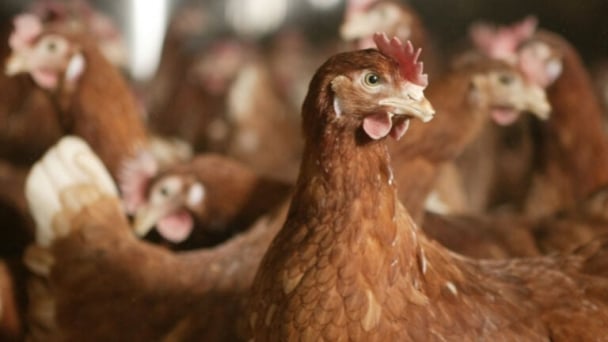June 30, 2025 | 06:29 GMT +7
June 30, 2025 | 06:29 GMT +7
Hotline: 0913.378.918
June 30, 2025 | 06:29 GMT +7
Hotline: 0913.378.918
Destructive and frequent locust plagues threaten the safety of agriculture, the economy and the environment globally. To control such outbreaks, large amounts of chemical pesticides are applied, raising severe concerns about food security, biodiversity loss, environmental pollution and human health.
Researchers from the Institute of Zoology under the Chinese Academy of Sciences and Peking University have achieved precise chemical control of the biosynthesis and release process of the locust aggregation pheromone 4VA. The study was published on Wednesday in the journal Nature.
AGGREGATION PHEROMONE
According to Kang Le from the Institute of Zoology, the study's corresponding author, solitary locusts can attract their counterparts by releasing pheromones, thereby forming large swarms.
Insect pheromones are trace chemicals produced and secreted by various glands or cells in insects and released outside their bodies. They are important chemical media for insect communication and play a significant role in behaviors such as courtship, mating, foraging, aggregation, oviposition and navigation.
For locusts, 4VA serves as a message for them to call their companions to form swarms. Locusts do not produce 4VA by themselves, but need to feed on the most common amino acid in plants to synthesize 4VA.
The team has identified the biosynthetic precursor compounds of 4VA and the key synthetic enzymes 4VPMT1 and 4VPMT2, by elucidating the complete biosynthetic pathway of this trace chemical substance.
ARTIFICIAL INTERVENTION
The team identified that 4VPMT1 and 4VPMT2 are not only the key enzymes in the biosynthesis of 4VA, but also important targets for controlling locust aggregation.
In addition, they discovered that 4-nitrophenol (4NP), which is commonly found in plants, has a higher binding affinity to these key enzymes than 4VP, and can easily occupy the active sites of 4VPMT1 and 4VPMT2 -- thereby inhibiting the biosynthesis of 4VA.
Based on this finding, researchers designed and developed specific small-molecule inhibitors, successfully achieving regulation of the locust aggregation pheromone and thus completing artificial directional intervention in locust aggregation behavior.
By achieving precise chemical control of the biosynthesis and release process of 4VA, researchers can send locusts a "fake message" to control the swarm.
PRECISE CONTROL
The development and utilization of insect pheromones provides a breakthrough method to precisely control pest behavior and promote green development.
According to Kang, people can use the new method to gather locusts together and apply chemical pesticides within a limited range, avoiding large-scale spraying and reducing ecological pollution.
Inhibitors can also be used for biological control of locusts. For instance, under aggregated conditions, locusts produce acetone cyanohydrin, which serves as a warning to predators such as birds and makes them reluctant to eat locusts.
After using inhibitors, it becomes difficult for locusts to aggregate. When they are dispersed, locusts no longer produce acetone cyanohydrin, and birds can then eat them -- thus achieving the goal of biological control.
(Chinadaily)
/2025/06/27/4654-2-213900_52.jpg)
(VAN) The Central Annamites Landscape Strategy for the 2025–2030 period sets a comprehensive direction for forest conservation, ecosystem restoration, and sustainable livelihood development.
![Lifting the IUU 'yellow card': [2] Thorough preparation for the EC inspection](https://t.ex-cdn.com/nongnghiepmoitruong.vn/608w/files/huytd/2025/06/27/3109-1-005033_548.jpg)
(VAN) Ahead of the fifth inspection by the EC, Khanh Hoa and Phu Yen have controlled fishing vessels, catch volumes at ports, and VMS equipment to meet the requirements for lifting the IUU 'yellow card.'

(VAN) Since the implementation of Resolution No. 03 by the People's Council of Tuyen Quang province, 282 organizations and individuals have been supported with advanced, water-saving irrigation systems, covering a total area of 765 hectares.
![Lifting the IUU 'yellow card': [1] Fisherpeople join forces](https://t.ex-cdn.com/nongnghiepmoitruong.vn/608w/files/huyenvt (e)/2025/06/26/0551-4-205700_585.jpg)
(VAN) To lift the EC's 'yellow card,' fisherpeople have significantly raised their awareness in complying with legal regulations in marine fishing activities.

(VAN) Research has shown that Hy-Line brown hens may be better suited for cage-free production based on overall greater egg production and other quality metrics.
![Turning wind and rain into action: [9] Digitizing hydrometeorological data in response to climate change](https://t.ex-cdn.com/nongnghiepmoitruong.vn/608w/files/news/2025/06/17/z6704423696987_15fd32ffc26d590d204d520c9dac6786-nongnghiep-165943.jpg)
(VAN) Farmers have begun accessing hydrometeorological applications to adjust their cropping schedules, aiming to ensure productivity and adapt to climate change.